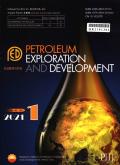Paleoclimate, paleoenvironment and source rock development model of Eocene in Shunde Sag, Pearl River Mouth Basin, China
IF 8
Q1 ENERGY & FUELS
引用次数: 0
Abstract
Based on the comprehensive analysis of data from petrology and mineralogy, well logging, seismic surveys, paleontology, and geochemistry, a detailed research was conducted on paleoenvironmental and paleoclimatic conditions, and modeling of the source rocks in the second member of the Eocene Wenchang Formation (Wen 2 Member) in the Northern Shunde Subsag at the southwestern margin of the Pearl River Mouth Basin. The Wen 2 Member hosts excellent, thick lacustrine source rocks with strong longitudinal heterogeneity and an average total organic carbon (TOC) content of over 4.9%. The Wen 2 Member can be divided into three units (I, II, III) from bottom to top. Unit I features excellent source rocks with Type I organic matters (average TOC of 5.9%) primarily sourced from lake organisms; Unit II hosts source rocks dominated by Type II2 organic matters (average TOC of 2.2%), which are originated from mixed sources dominated by terrestrial input. Unit III contains good to excellent source rocks dominated by Type II1 organic matters (average TOC of 4.9%), which are mainly contributed by lake organisms and partially by terrestrial input. Under the background of rapid subsidence and limited source supply during intense rifting period in the Eocene, excellent source rocks were developed in Wen 2 Member in the Northern Shunde Subsag under the coordinated control of warm and humid climate, volcanic activity, and deep-water reducing conditions. During the deposition of Unit I, the warm and humid climate and volcanic activity promoted the proliferation of lake algaes, primarily Granodiscus, resulting in high initial productivity, and deep-water reducing conditions enabled satisfactory preservation of organic matters. These factors jointly controlled the development and occurrence of excellent source rocks. During the deposition of Unit II, a transition from warm to cool and semi-arid paleoclimatic conditions led to a decrease in lake algaes and initial productivity. Additionally, enhanced terrestrial input and shallow-water, weakly oxidizing water conditions caused a significant dilution and decomposition of organic matters, degrading the quality of source rocks. During the deposition of Unit III, when the paleoclimatic conditions are cool and humid, Pediastrum and Botryococcus began to thrive, leading to an increase in productivity. Meanwhile, the reducing environment of semi-deep water facilitated the preservation of excellent source rocks, albeit slightly inferior to those in Unit I. The study results clarify the differential origins and development models of various source rocks in the Shunde Sag, offering valuable guidance for evaluating source rocks and selecting petroleum exploration targets in similar marginal sags.
珠江口盆地顺德凹陷始新世古气候、古环境与烃源岩发育模式
在综合岩石矿物学、测井、地震、古生物、地球化学等资料的基础上,对珠江口盆地西南缘顺德洼陷北部始新统文昌组二段(文二段)古环境古气候条件进行了详细研究,并对烃源岩进行了模拟。温二段烃源岩质量优良,厚度大,纵向非均质性强,平均总有机碳(TOC)含量超过4.9%。文2成员可分为三个单元(I, II, III)从下到上。单元1烃源岩优良,ⅰ型有机质(平均TOC为5.9%)主要来源于湖泊生物;II单元烃源岩以II2型有机质为主(平均TOC为2.2%),烃源岩以陆源输入为主。III单元含良至优烃源岩,以II1型有机质为主(平均TOC为4.9%),主要由湖泊生物贡献,部分由陆源输入。在始新世强烈裂陷期快速沉降和烃源岩供应有限的背景下,顺德洼陷北部文二段在暖湿气候、火山活动和深水减持条件的共同控制下发育了优质烃源岩。在第1单元沉积期间,温暖湿润的气候和火山活动促进了湖泊藻类(主要是花岗盘藻)的增殖,导致了较高的初始生产力,深水还原条件使有机质得到了较好的保存。这些因素共同控制了优质烃源岩的发育和赋存。在第二单元沉积期间,从温暖到凉爽和半干旱的古气候条件的转变导致了湖泊藻类和初始生产力的减少。此外,陆源输入增加和浅水弱氧化水条件导致有机质明显稀释和分解,烃源岩质量下降。在第三单元沉积期间,当古气候条件凉爽湿润时,Pediastrum和Botryococcus开始繁殖,导致生产力提高。同时,半深水还原环境有利于优质烃源岩的保存,但略逊于1单元烃源岩。研究结果明确了顺德凹陷各类烃源岩的成因差异和发育模式,为类似边缘凹陷烃源岩评价和油气勘探目标选择提供了有价值的指导。
本文章由计算机程序翻译,如有差异,请以英文原文为准。
求助全文
约1分钟内获得全文
求助全文

 求助内容:
求助内容: 应助结果提醒方式:
应助结果提醒方式:


